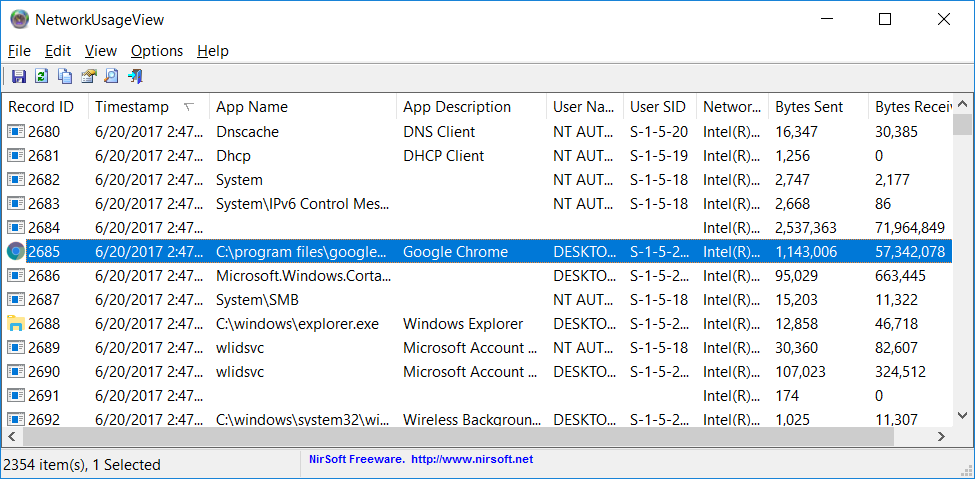Always scroll to the bottom of the page for the main download link.
We don't believe in fake/misleading download buttons and tricks. The link is always in the same place.
NetworkUsageView v1.31
Extracts and displays the network usage information stored in the SRUDB.dat database of Windows 8, Windows 10, and Windows 11.
The network usage data is collected every hour by Windows operating systems and includes the following information: The name and description of the service or application, the name and SID of the user, the network adapter, and the total number of bytes sent and received by the specified service/application.

System Requirements
This tools works on Windows 8, Windows 10, and Windows 11. Previous versions of Windows are not supported because the operating system doesn't collect the network usage information.
Changes:
Version 1.31:
Added 'Sort By' toolbar button
Start Using NetworkUsageView
NetworkUsageView doesn't require any installation process or additional DLL files. In order to start using it, simply run the executable file - NetworkUsageView.exe
After running NetworkUsageView - if the SRUDB.dat database file is locked , NetworkUsageView will ask you whether you want to run it as administrator in order to access the locked file. If the file is not locked, NetworkUsageView will load it instantly.
'Advanced Options' Window
In the 'Advanced Options' window (F9), you can choose to load the SRUDB.dat database from external drive or from a remote computer on your network. Be aware that loading the network usage information from a remote computer works only when the database file on the remote computer is not locked.
You can also choose to load the network usage data from the last xx days hours or from the specified date/time range.
NetworkUsageView Columns
Record ID: The ID of the record in the SRUDB.dat database.
Timestamp: The date/time that this record was created.
App Name: The name if the application or service.
App Description: The description of application or service. If the 'App Name' is .exe filename, the description is taken from the version resource of the .exe file. if the 'App Name' is a service, the description is taken from the description string of the service.
User Name: The name of the user according to the user SID specified in the SRUDB.dat database. This field is empty when reading a file from external drive.
User SID: SID of the user.
Bytes Sent: Total number of bytes that the specifies app/service sent.
Bytes Received: Total number of bytes that the specifies app/service received.
Network Adapter: The name of the network adapter that was used to send/receive data (This field is empty for remote and external drive modes).
Command-Line Options
/stext <Filename> Save the network usage information into a simple text file.
/stab <Filename> Save the network usage information into a tab-delimited text file.
/scomma <Filename> Save the network usage information into a comma-delimited text file (csv).
/stabular <Filename> Save the network usage information into a tabular text file.
/shtml <Filename> Save the network usage information into HTML file (Horizontal).
/sverhtml <Filename> Save the network usage information into HTML file (Vertical).
/sxml <Filename> Save the network usage information into XML file.
Translating NetworkUsageView to other languages
In order to translate NetworkUsageView to other language, follow the instructions below:
Run NetworkUsageView with /savelangfile parameter:
NetworkUsageView.exe /savelangfile
A file named NetworkUsageView_lng.ini will be created in the folder of NetworkUsageView utility.
Open the created language file in Notepad or in any other text editor.
Translate all string entries to the desired language. Optionally, you can also add your name and/or a link to your Web site. (TranslatorName and TranslatorURL values) If you add this information, it'll be used in the 'About' window.
After you finish the translation, Run NetworkUsageView, and all translated strings will be loaded from the language file.
If you want to run NetworkUsageView without the translation, simply rename the language file, or move it to another folder.
License
This utility is released as freeware. You are allowed to freely distribute this utility via floppy disk, CD-ROM, Internet, or in any other way, as long as you don't charge anything for this and you don't sell it or distribute it as a part of commercial product. If you distribute this utility, you must include all files in the distribution package, without any modification !
Disclaimer
The software is provided "AS IS" without any warranty, either expressed or implied, including, but not limited to, the implied warranties of merchantability and fitness for a particular purpose. The author will not be liable for any special, incidental, consequential or indirect damages due to loss of data or any other reason.
Feedback
If you have any problem, suggestion, comment, or you found a bug in this utility, you can send a message to nirsofer@yahoo.com
This download is for the 64bit version. If you need the 32bit version, download here.
Click here to visit the author's website.
Continue below for the main download link.
|












 , out of 71 Votes.
, out of 71 Votes.
